Chinese New Zealanders — a dynamic history
Check out our latest Topic Explorer set: Chinese New Zealanders. This resource investigates and celebrates Aotearoa New Zealand’s dynamic Chinese heritage through images, text, early newspaper articles and more.
Chinese New Zealanders 新西蘭華人 | 新西兰华人
Chinese New Year begins on 10 February and according to the Chinese zodiac, 2024 is the Year of the Wood Dragon. Chinese dragons are respected and honoured, not only for their strength and wisdom but success as well.
Dragons may be mythical creatures but their representations have become familiar to New Zealanders over recent decades. Have you been thrilled by dragon boat racing? Or watched a sinuous dragon dance? Or gazed in awe at an illuminated dragon during a Chinese lantern festival?
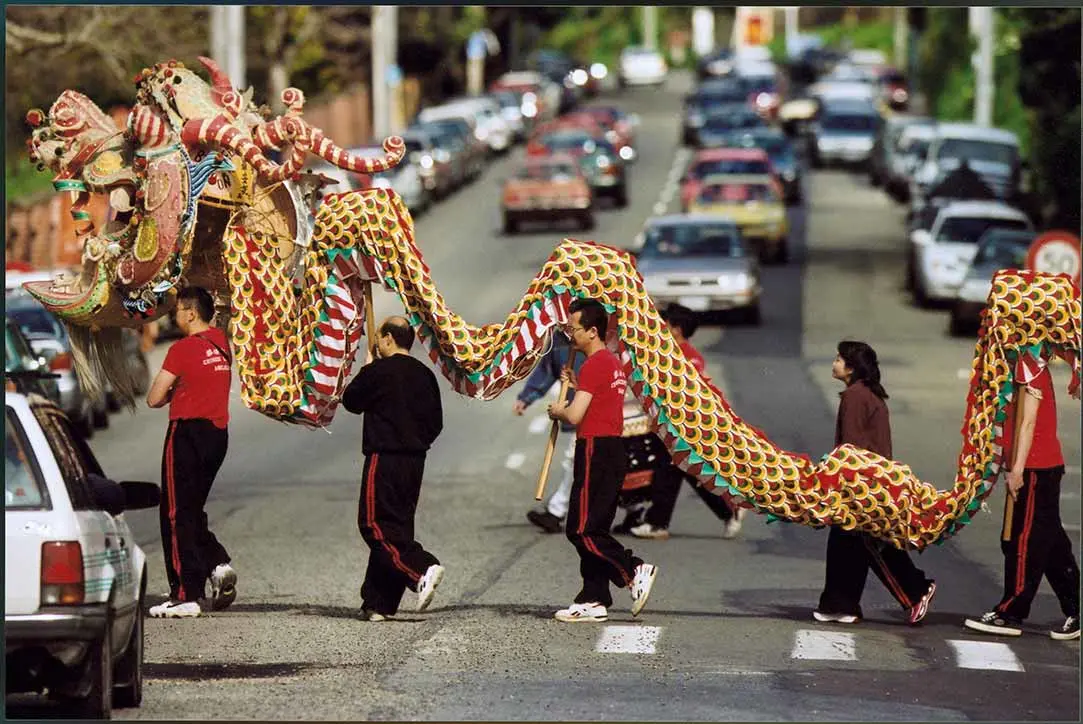
Chinese dragon being carried across a pedestrian crossing, Wellington, as part of the Anglican Chinese Mission and Chinese Centre's annual Chinese bazaar.
Image credit: Chinese dragon carried across a pedestrian crossing, 1999 by Craig Simcox, Evening Post. Ref: EP/1999/2748/17 Alexander Turnbull Library.
Like the Wood Dragon, Chinese New Zealanders are a highly respected community of around 250,000 people (2018 Census) and have been an integral part of Aotearoa New Zealand over the last two centuries.
While they have faced active marginalisation and discrimination at community and legislative levels, their legacy and contributions continue to have a lasting impact on our culture and economy. For example, during World War 2, Chinese market gardeners had a pivotal role in New Zealand’s war effort by supplying produce to New Zealand and American troops.
A new resource for schools
Chinese New Zealanders is our latest online Topic Explorer set for ākonga and kaiako and aligns with te ao tangata | social sciences curriculum.
As a resource, it investigates and celebrates New Zealand’s dynamic Chinese heritage through curated images, text, early newspaper articles from our collections, and more.
Four stories make up the Chinese New Zealanders set:
Chinese gold miners, 1865 onwards
Chinese New Zealanders, 1880s–1940s: building lives
Chinese New Zealanders, 1940s–2020s: new worlds
Legislation and policy enacted against Chinese in New Zealand.
View the full resource here: Chinese New Zealanders.
New Gold Mountain
The first story looks at Chinese gold miners, the arrival and industry of Chinese in Te Waipounamu | South Island, Otago and Te Tai Poutini | West Coast goldfields.
Many Chinese gold seekers were from the Guǎngzhōu province in Southern China and New Gold Mountain was their name for New Zealand.
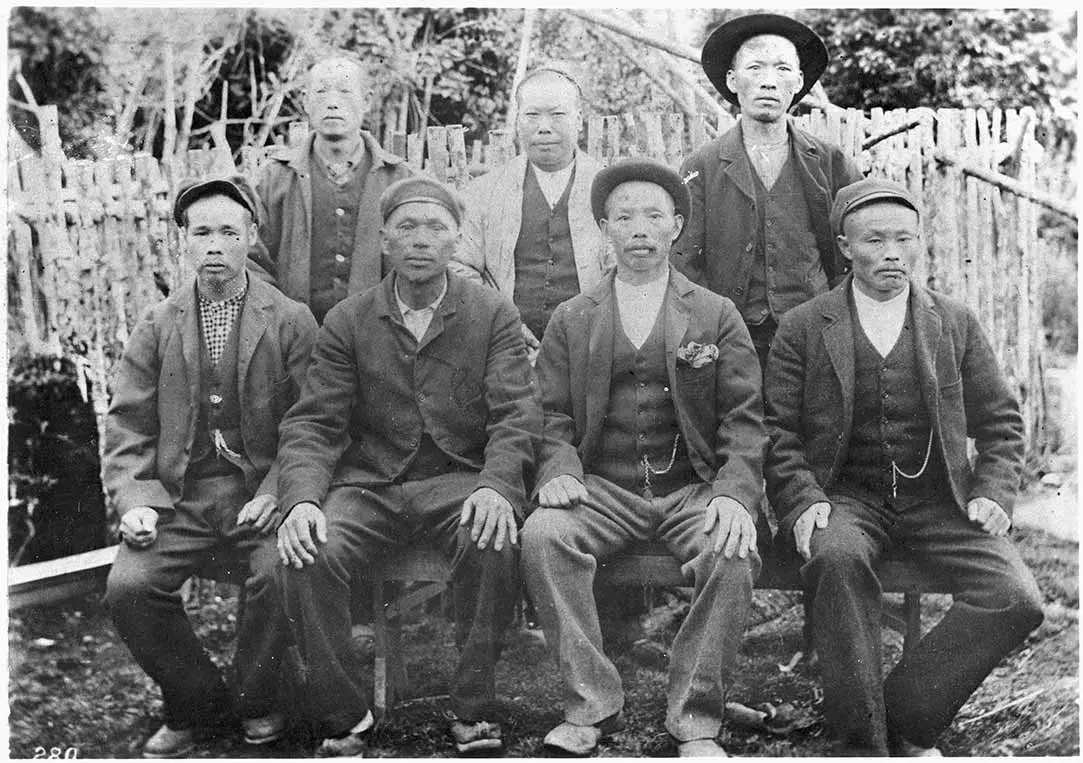
Chinese gold miners at Orepuki. Back row: Chan Choi, Chan Sum, Chan Foon. Front row: Chan Shek, Chan Kwan Jeong, Chan Yeung, Lai Wei Shi. Orepuki was once a thriving gold mining town some 50 minutes west of Invercargill.
Image credit: Chinese gold miners at Orepuki, ca 1860s. Photographer unknown. Ref: 1/2-019142-F Alexander Turnbull Library.
Building lives: 1880s–1940s
The second story looks at what happened after Te Waipounamu | South Island gold rushes. During this era, Chinese settler careers expanded as they took up intensive vegetable cultivation (market gardening), greengrocer and laundry occupations.
While these occupations involved hard physical work and long hours, they also resulted in successful businesses for many Chinese. For example, by 1945, 6,800 hectares were in vegetable cultivation and market gardeners were producing a surplus of vegetables.
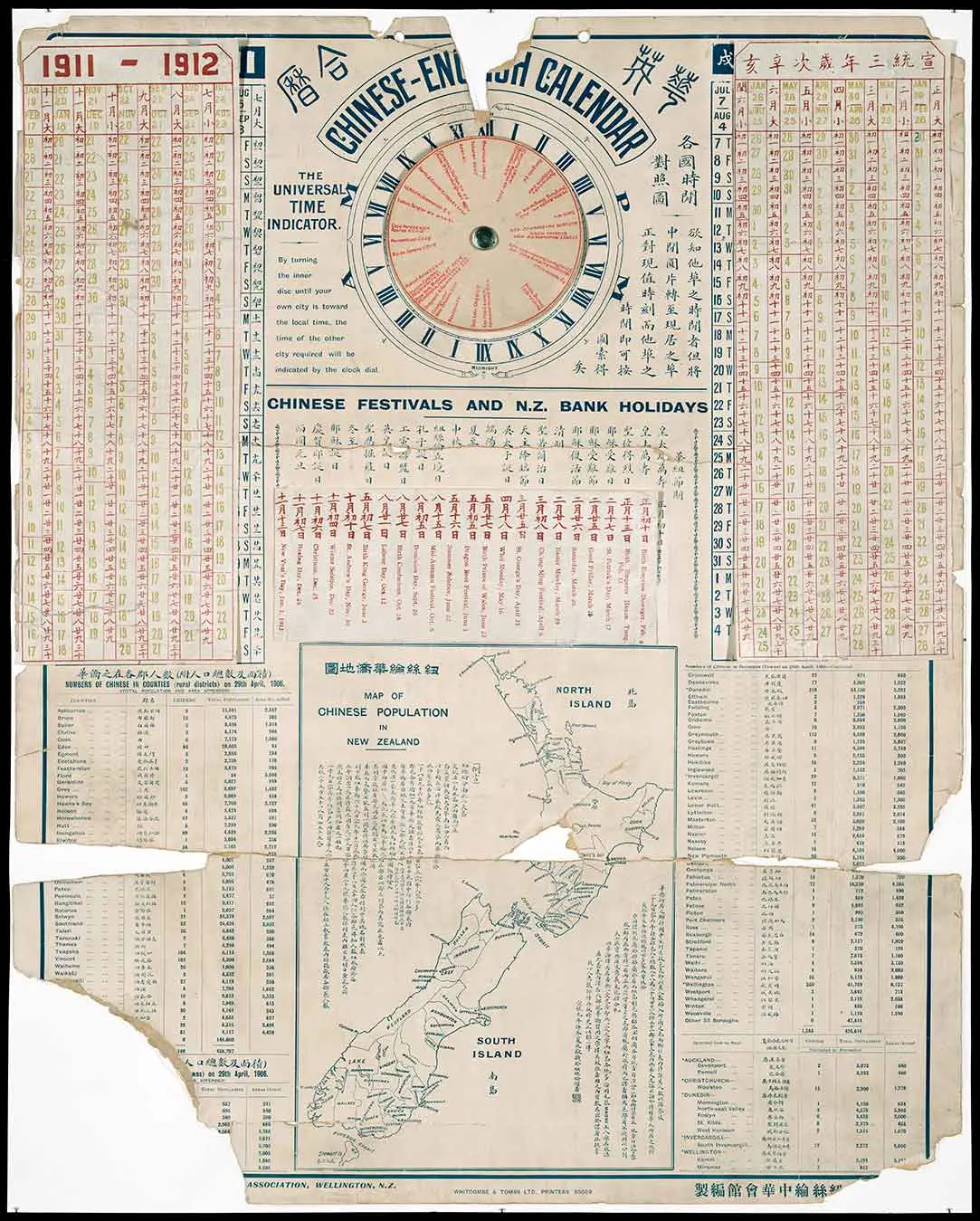
This calendar shows Chinese festivals and New Zealand bank holidays, and the number of Chinese in New Zealand cities and small towns.
Image credit: Chinese-English calendar, 1910–1911 and 1911–1912 by New Zealand Chinese Association. Printed by Whitcombe & Tombs Ltd. Ref: Eph-D-CALENDAR-1910-01 Alexander Turnbull Library.
New Worlds: 1940s–2020s
The third story looks at the recent emergence of a vibrant local Chinese culture and arts scene, Chinese immigration (from the 1990s) and gender, demographic and occupational shifts. According to the 2018 census, 46% of Chinese in New Zealand are in professional or managerial occupations.
Another change has been geographic. In 1871, the majority of the Chinese in New Zealand were living in the west and south of Te Waipounamu | South Island.
Today, around 70% of Chinese live in the Tāmaki Makaurau | Auckland region (2018 Census).
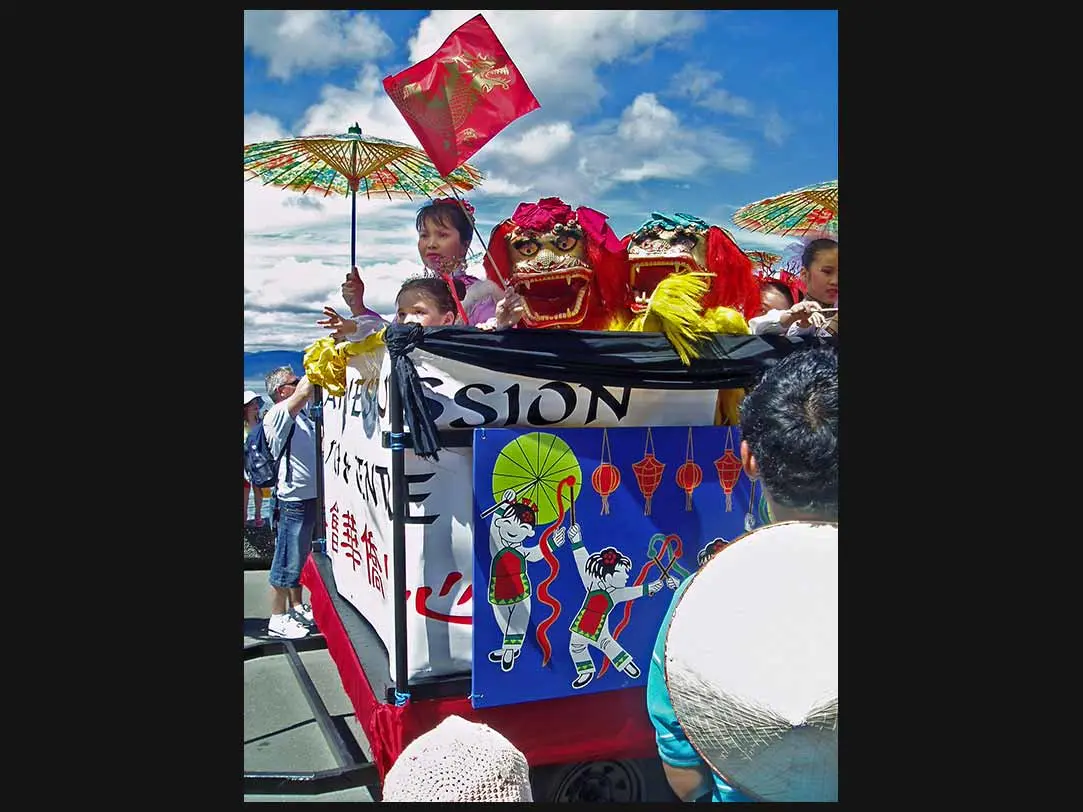
Chinese New Year celebrations, Te Whanganui-a-Tara waterfront, 2006.
Image credit: Photographs of Chinese New Year celebrations, Frank Kitts Park, Wellington, 2006 by Dylan Owen. Ref: PADL-000175 Alexander Turnbull Library. Black background added.
Legislation and policy enacted against Chinese in New Zealand
This last story looks at the history of discrimination against Chinese settlers. Initially, it began on the goldfields, reaching its peak with the introduction of the 1881 Chinese Immigrants Act, commonly referred to as the ‘poll tax’. This legislation required all Chinese immigrants to pay 10 pounds upon entry to New Zealand. Fifteen years later, it was increased to 100 pounds. The Chinese Immigrants Act was repealed in 1944.
On 12 February 2002, at a Chinese New Year celebration, Prime Minister Helen Clark made a statement formally apologising to Chinese people who paid the poll tax and suffered discrimination.
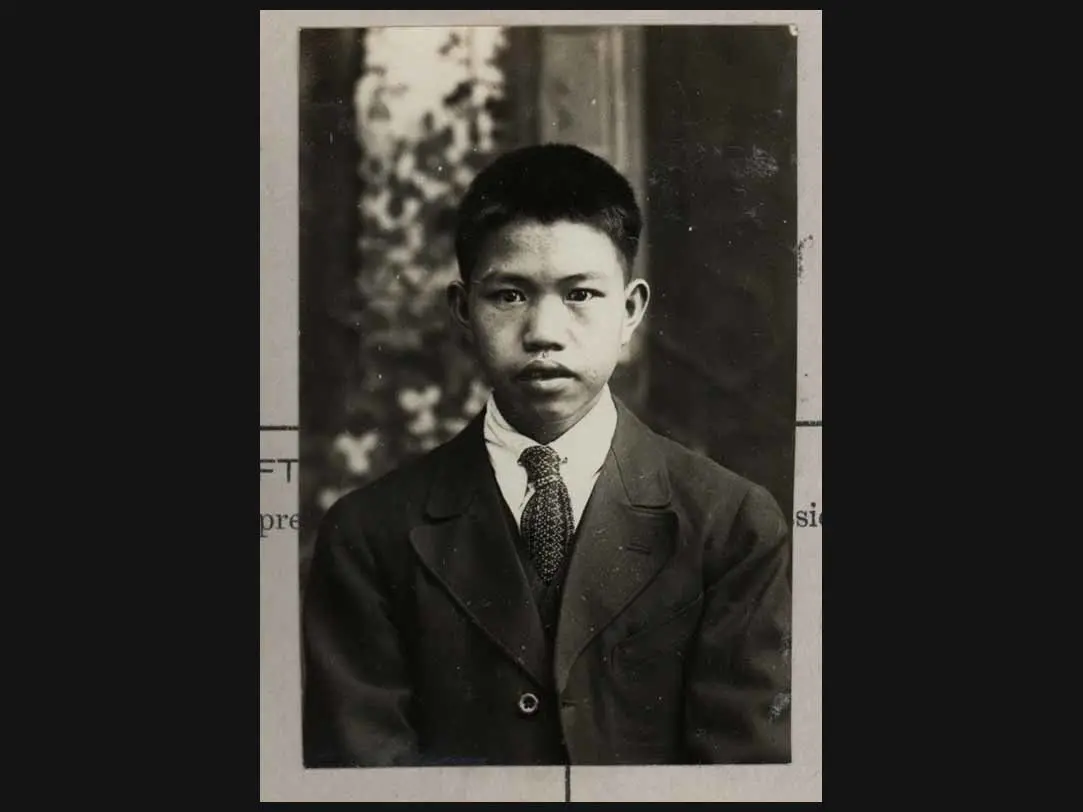
Chong Ngan, 1922. Chong Ngan was only 18 when this photograph was taken on his arrival in New Zealand. The image is part of a receipt from a poll tax book held by Archives New Zealand. Many receipts contained a formal portrait photograph or fingerprints. Chong Ngan paid a £100 poll tax which at the time was equivalent to 2 years of wages for a full-time labourer in New Zealand.
Image credit: 1881 Poll Tax. Archives New Zealand on Flickr. Some rights reserved: CC BY 2.0 DEED. Black background added.
Explore Chinese New Zealanders through primary sources
Many of the items that feature in Chinese New Zealanders are historical primary sources (original, first-hand records about people, places, taonga and events), like the following photo of a family in their greengrocer's store.
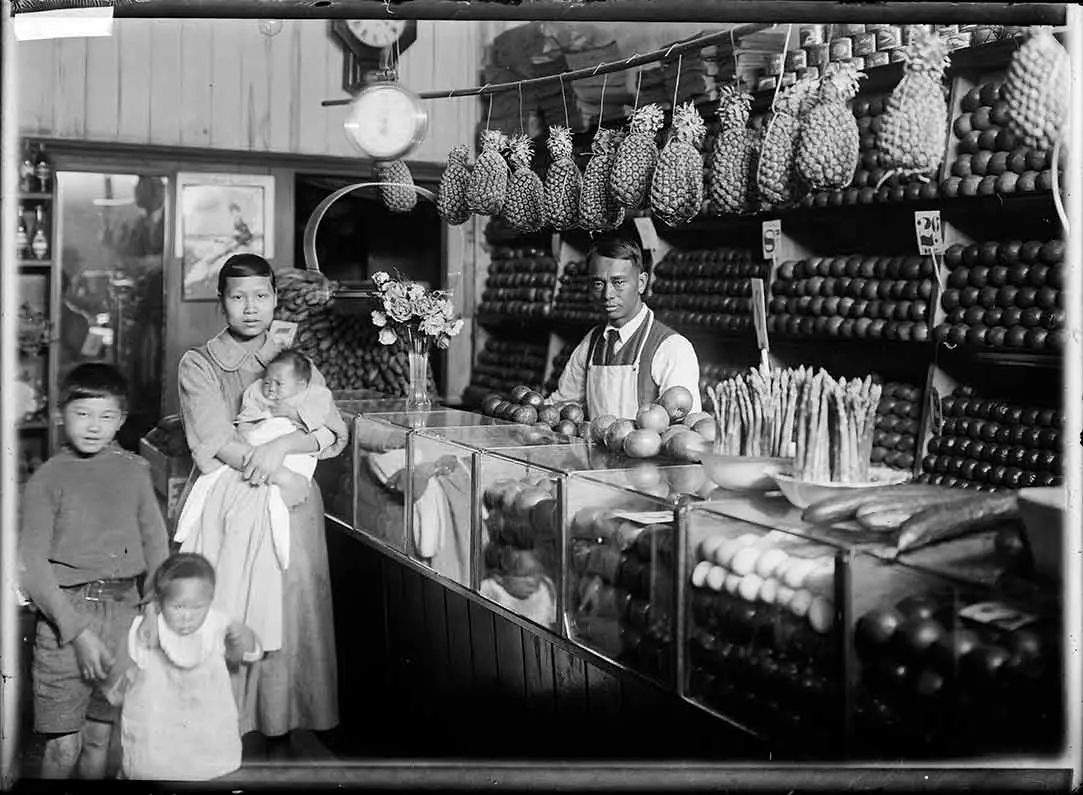
Wong Gar Sui with his wife Chung Mew Yuen and children in their Auckland greengrocer’s shop, around 1922.
Image credit: Chinese family in a greengrocer's shop, 1922. Photographer unknown. Ref: 1/2-037502-G Alexander Turnbull Library.
Primary sources like these provide insights into the lives and experiences of Chinese New Zealanders.
National Library Services to Schools has developed a suite of primary source analysis tools.
Our tools are designed for ākonga from years 1 to 13 to stimulate curiosity, identify different perspectives and build an understanding of concepts such as authorship and purpose.
Using our tools
Ākonga can examine the photo above by asking questions and following prompts from our photo analysis tools. For example:
What do I think happened just before/after this photo was taken?
What would this photo show me if taken at a different time?
Who took this photo and why?
Ākonga could investigate even deeper by reflecting on the technology (shop scales) that appears, and how and why were they used. They could also examine the style of clothing worn by different family members. Do we wear these types of clothes today?
These questions help uncover clues about people’s experiences and perspectives. The prompts in our tools are designed to help develop observation and critical thinking skills. For example, by working through our photo tools, ākonga can figure out this photo was taken in spring. How? Because September to December is the growing season for asparagus which appears on the counter.
Use our tools to explore different primary sources such as artwork, objects, and unpublished and published documents.
Resources to spark curiosity and build understanding
Here is a selection of resources to learn about Chinese New Zealanders from the National Library.
Topic Explorer has:
Te Kupenga: Stories of Aotearoa New Zealand has the following:
Many Answers has entries on:
Encourage ākonga to use AnyQuestions, a free online chat service to get help with their research and inquiry questions. The service is open between 1pm and 6pm on weekdays.
Explore our primary source analysis tools:
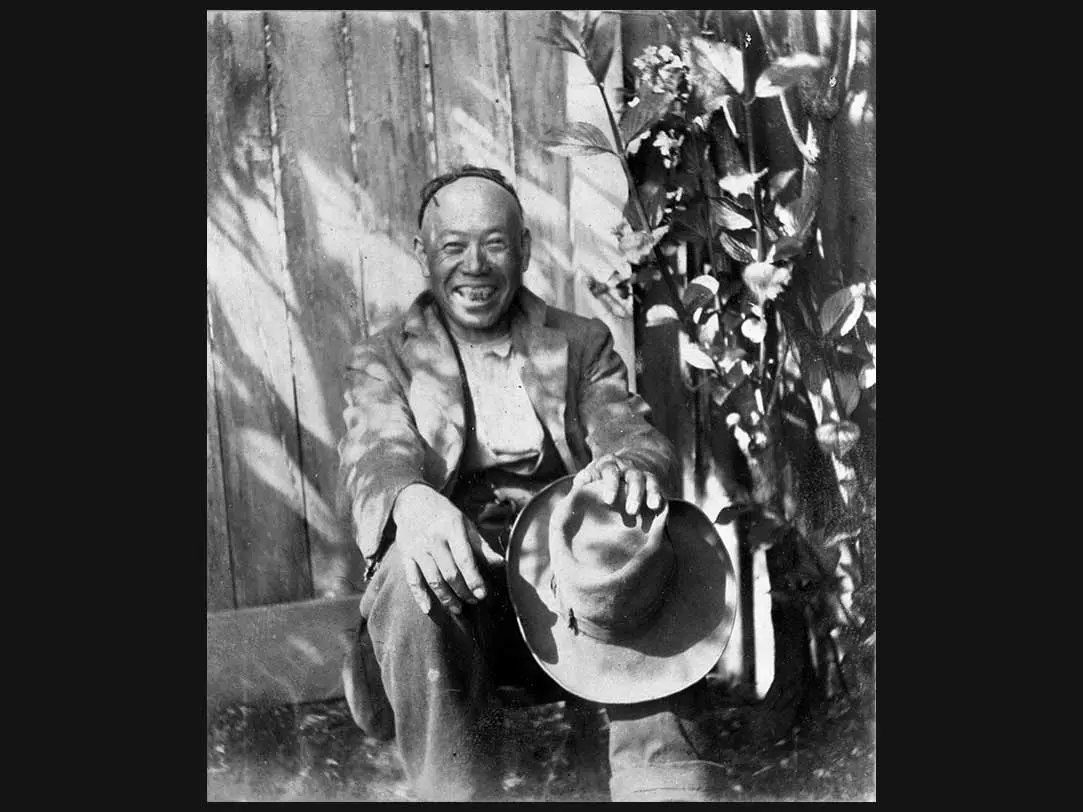
This is Joe Tie, aged 62. He arrived in New Zealand in 1869. He is outside his home which was between Rutherglen and Marsden.
Image credit: West Coast gold miner, ca 1900–1940. Photographer unknown. Ref: 1/2-096929-F Alexander Turnbull Library. Black background added.
Working together to celebrate a vibrant culture and history
To ensure Services to Schools created an accurate and contemporary reflection of Chinese New Zealand history, we collaborated with these New Zealand Chinese Association representatives:
Kirsten Wong (researcher and Chinese cultural advisor)
Lynette Shum (Oral History Advisor Alexander Turnbull Library).
Thank you Kirsten and Lynette for valuable guidance, feedback, text and content recommendations.
One highlight was Kirsten supplying names to some of the photos featuring (anonymous) Chinese gold seekers and business owners in our curated photos including the photograph above of Joe Tie.
A special thank you also to Emeritus Professor Manying Ip who kindly reviewed this resource before publication.
Thanks to this collaboration, we have a resource rich in primary sources to support ākonga and kaiako to learn about, reflect on and celebrate the vibrant culture and history of the New Zealand Chinese community.
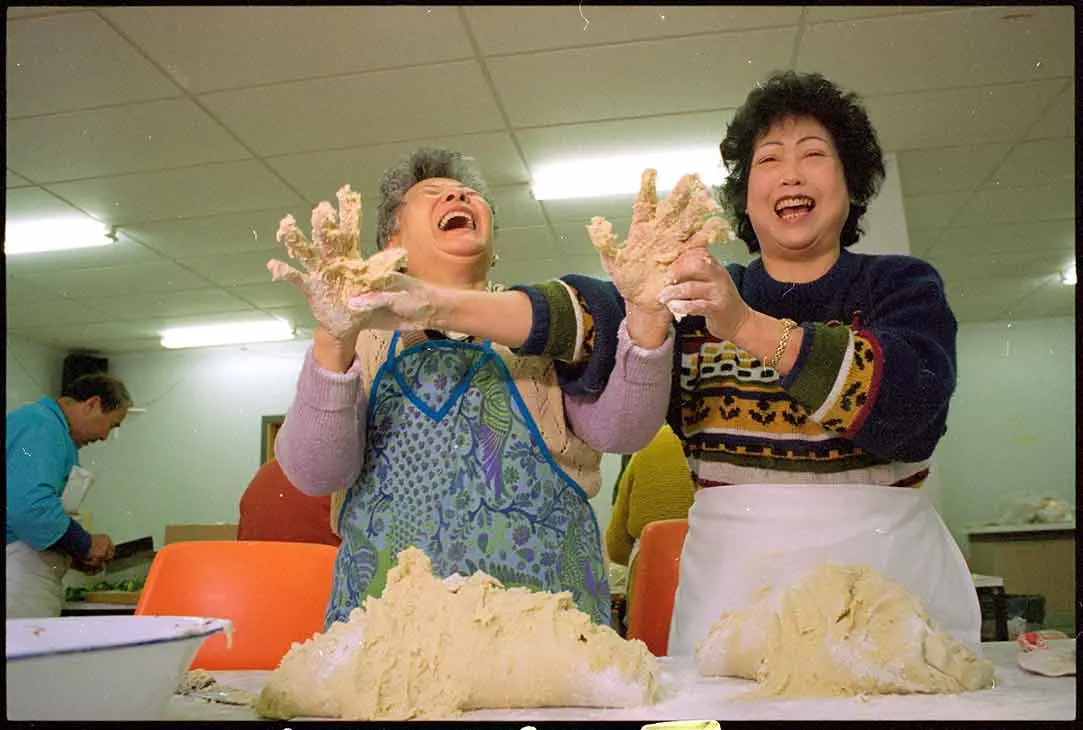
Image credit: Ng Soon Yee and Mel Jean Chin preparing red bean dumplings for the Anglican Chinese bazaar in Wellington, 1995 by Ross Giblin. Evening Post. Ref: EP/1995/3963/8-F Alexander Turnbull Library.